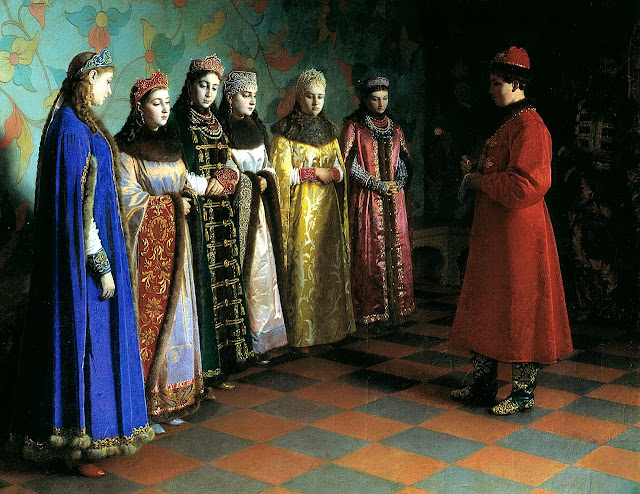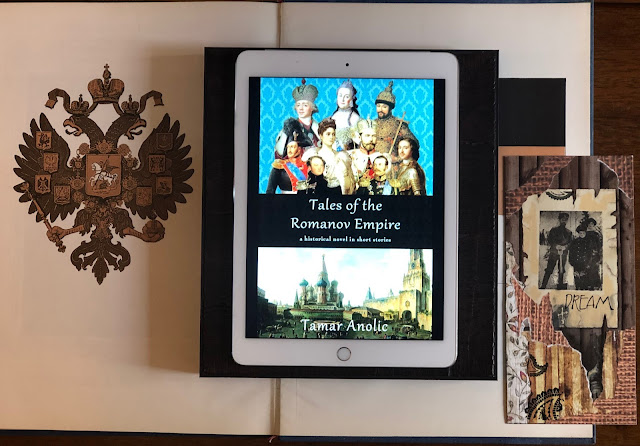Tales of the Romanov Empire by Tamar Anolic is a collection of short stories, depicting the rise and fall of the Romanov dynasty. It covers a long period of the Russian history between 1613 to 1918.
The book is a fictionalised account of the Russian tsars, which sheds light on the more obscure figures of the Russian history.
It begins with the first Romanov tsar, Mikhail Feodorovich who came to power at the age of sixteen. The boyar council in Muscovy has elected him Tsar, as they believed him to be the only person that can unite them and end the long years of war. We meet him as a shy boy hiding in St Ipatiev monastery with his mother in March 1613. Both of his parents were forcibly tonsured during the war. His mother, formidable Marfa, is against Mikhail accepting the throne of Muscovy.
In his address to the Zemstvo Council he said. "I have become a tsar at your wish and not at my will. I have been elected a sovereign by the whole state. You kissed my cross willingly. You have promised to serve me, be honest before me and join your forces with me. Today we witess plunder, killings and disorder of various kinds... You should remove these troubles and put everything in order" (as quoted in The Romanov Dynasty in the Fine Arts, 1993)
1646.
One of the chapters tells a fascinating story of the bride show staged to help young Tsar Alexei (Mikhail's son) find a spouse. He is only 17, but the Patriarch and Duma are expecting him to marry. The dynasty is still in its infancy, and has to be secured.
The Tsar's Brideshow has been a custom originating in the Byzantine times, when the tsar/emperor would choose a wife from among the most beautiful and healthy maidens in the country.
The marriage politics are truly Macchiavelian. The trusted boyars push forward their own candidates and plot against the competition. The most beautiful young girls from the aristocratic families would gather in Moscow, where their family tree, medical histories, appearance and virtue would be appraised. The final selected six would be presented to the tsar. The tsar inspects the candidates and chooses his bride.
Alexei's original choice was Efimia Feodorovna Vsevolozhskaia. Her hair was pulled so tightly for the bride show that she has fainted after the marriage proposal. Immediately she and her family were accused of treason, and sent into exile. Alexei will marry Maria Miloslavskaya, the candidate promoted by the power-greedy boyars around him.
If Alexei married his first choice, the Russian history could have been completely different. As it happened, he had thirteen children with three consecutive wives. His oldest surving daughter Sophia would become the Regent of Russia from 1682 to 1689.
Sophia is a controversial figure in the Russian history. Her reign was tumultous, but when you look at the miserable lives of the royal daughters who were condemned to the life inside the terem, unmarried and almost prisoners, or sent to the monastery, you have some sympathy to her quest for power.
Alexei's son with Natalya Naryshkina would become the indomitable Peter the Great, who ruled the tsardom of Russia and later the Russian Empire from 1682 to 1725.
Under his reign Russia has been modernised and has become a strong European power.
The battle of Poltava has its own chapter, called Victory! Victory! Victory! As I was reading it, an old song from the 19C kept playing in my mind, There was a battle by Poltava (Bylo delo pod Poltavoi), which describes how the Russian army fought against the Swedish army. Peter himself was the target for the enemy's bullets. His hat was hit, then the saddle of his horse, and later the cross on his chest saved him. Peter didn't consider moving to a position of safety. He believed that God was looking out for him.
The stories progress in the chronological order, where we encounter Elizaveta, Catherine the Great, Paul, Alexander I, Nicholas I, Alexander II, Alexander III and Nicholas II. We also get to know the minor, more obscure, Romanovs, younger brothers and uncles and their families.
The abdication of Nicholas II makes a sombre reading. "Three centuries of Romanov rule undone by the stroke of a pen".
The final chapters provide a fascinating insight in the events leading to the abdication and downfall of Nicholas II.
This is an ambitious project, given the challenging time scale and number of characters. Anolic has clearly done some excellent research.
Given the extent of the dynasty's ruthlessness and thirst for power, the portrayal of the Romanovs is too sympathetic and forgiving, even romanticised. Blood-thirsty and unscrupulous, many of them removed their nearest and dearest without compunction.
I have read an e-copy, so I'm not sure what the paper edition looks like, but it would certainly benefit from having a family tree page and illustrations, like portraits of the main characters.
Some of the tales are told in the 1st person, while most of them are in the 3rd person, there is no consistency of narrative. It's not easy to get the 1st person narrative right, when you feel the emotional connection to the character.
Certain tales seem to be quite random, for example, Blood on the steppes is the tale of the children kidnapped and sold into slavery. If that is to show one of the historical aspects of the Romanov dynasty, then it is slightly perfunctory. Sadly, this atrocity has been happening for many centuries. Also if I might add, nobody would call a child by their name/patronymic/surname, especially if they were peasants or serfs.
The book is dedicated to Wolf Anolic, the author's great grandfather who was the inspiration behind the character of Wolf Rosen, who had the courage to flee the tsarist persecution in search of a better life in America. Wolf's escape from the pogroms is a fascinating story, but it doesn't appear integrated amidst the Romanovs' tales. For me it feels like a basis for a separate book, which I would love to read. I can see why the author wanted to include it in the book, but it doesn't organically merge with the main narrative.
"Up ahead, Wolf saw the most famous landmark in all the world. A tall green statue, wearing long robes, a crown adorning her head. Her arm was raised upwards, holding her torch high. The clouds parted, sending a ray of light onto Lady Liberty. The warm amber sunlight made her lit torch glow all the brighter - a beacon of hope against hatred and oppression".
Tales of the Romanov Empire is a compelling, colourful collection of stories, with a huge cast of characters. It would appeal to anyone interested in the Russian history, especially the dramatic story of the Romanov family.
Many thanks to Tamar Anolic and NetGalley for my e-copy of the book!





No comments:
Post a Comment